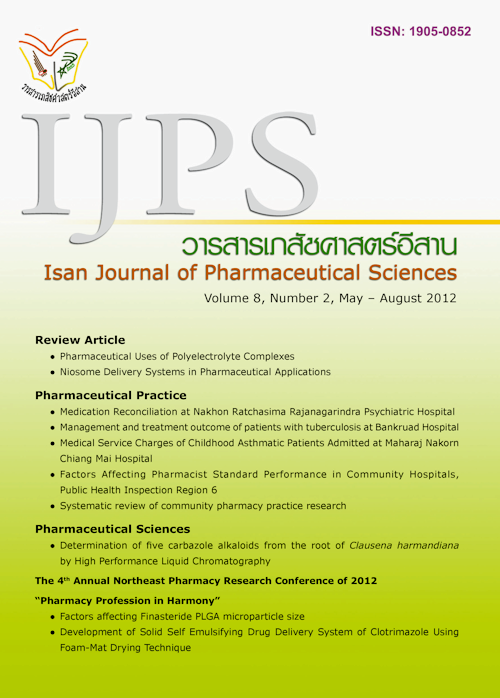Pharmaceutical Uses of Polyelectrolyte Complexes
Main Article Content
Abstract
Since the 1990s, drug delivery technologies have developed extensively, including systems utilizing polyelectrolyte complexes. In this technology, the system is formed by oppositely charged molecules, resulting in the precipitation of small particles. Polyelectrolyte complexes are divided into two groups: polyelectrolyte-polyelectrolyte (PE-PE) and polyelectrolyte-surfactant (PE-Surf). Herein, PE-PE is focused upon. In this review article, theories of formation, factors influencing complexation, particularly, the effects of salt, polymer structure, temperature, and mixing ratios are mentioned. Moreover, evaluation of the interaction between polyelectrolytes, the uses in the pharmaceutical arena, for example, the delivery of vancomycin for colon targeting, the uses of PE-PE as membranes or thin films for coating and the cytotoxicity of PE-PE are discussed.
Article Details
In the case that some parts are used by others The author must Confirm that obtaining permission to use some of the original authors. And must attach evidence That the permission has been included
References
Beheshti N, Zhu K, Kjøniksen AL, Nyström B. Characterization of complexation and phase behavior of mixed systems of unmodified and hydrophobically modified oppositely charged polyelectrolytes. Colloid Polym Sci 2010; 288(10-11): 1121-1130.
Bigucci F, Luppi B, Cerchiara T, et al. Chitosan/pectin polyelectrolyte complexes: Selection of suitable preparative conditions for colon-specific delivery of vancomycin. Eur J Pharm Sci 2008; 35(5): 435-441.
Cerea M, Zheng W, Young CR, McGinity JW. A novel powder coating process for attaining taste masking and moisture protective films applied to tablets. Int J Pharm 2004; 279(1-2): 127-139.
Chatelet C, Damour O, Domard A. Influence of the degree of acetylation on some biological properties of chitosan films. Biomaterials 2001; 22(3): 261-268.
Chen X, Liu J, Feng Z, Shao Z. Macroporous chitosan/carboxymethylcellulose blend membranes and their application for lysozyme adsorption. J Appl Polym Sci 2005; 96(4): 1267-1274.
Daubiné F, Cortial D, Ladam G, et al. Nanostructured polyelectrolyte multilayer drug delivery systems for bone metastasis prevention. Biomaterials2009; 30 (31): 6367-6373.de
Vasconcelos CL, Bezerril PM, dos Santos DE, Dantas TN, Pereira MR, Fonseca JL. Effect of molecular weight and ionic strength on the formation of polyelectrolyte complexes based on poly(methacrylic acid) and chitosan. Biomacromolecules 2006; 7(4): 1245-1252.
Fredheim GE, Christensen BE. Polyelectrolyte complexes: Interactions between lignosulfonate and chitosan. Biomacromolecules 2003; 4(2): 232-239.
Fuoss RM, Sadek H. Mutual interaction of polyelectrolytes. Science 1949; 110: 552-554.
Giordano C, Causa F, Candiani G. Gene therapy: The state of the art and future directions. J Appl Biomater Biomech 2006; 4(2): 73-79.
Gucht Jvd, Spruijt E, Lemmers M, Cohen Stuart MA, Polyelectrolyte complexes: Bulk phases and colloidal systems. J Colloid Interf Sci 2011; 361(2): 407-422.
Hahn SK, Hoffman AS. Preparation and characterization of biocompatible polyelectrolyte complex multilayer of hyaluronic acid and poly-L-lysine. Int J Biol Macromol 2005; 37(5): 227-231.
Hamley LW, Hiscutt EL, Yang Y, Booth C. Dewetting of thin block copolymer films. J Colloid Interf Sci1999; 209(1): 255-260.
Hamman JH. Chitosan based polyelectrolyte complexes as potential carrier materials in drug delivery systems. Mar Drugs 2010; 8(4): 1305-1322.
Hartig SM, Greene RR, Carlesso G, et al. Kinetic analysis of nanoparticulate polyelectrolyte complex interactions with endothelial cells. Biomaterials2007; 28(26): 3843-3855.
Jiang H, Zuo Y, Cheng L, Wang H, Gu A, Li Y. A homogenous CS/NaCMC/n-HA polyelectrolyte complex membrane prepared by gradual electrostatic assembling. J Mater Sci Mater Med 2011; 22(2): 289-297.
Lankalapalli S, Kolapali VRM. Polyelectrolyte complexes: A review of their applicability in drug delivery technology. Indian J Pharm Sci 2009; 71(5): 481-487.
Lu X, Gao H, Li C, et al. Polyelectrolyte complex nanoparticles of amino poly(glycerol methacrylates) and insulin. Int J Pharm 2012; 423(2): 195-201.
Martí nez-Ruvalcaba A, Chornet E, Rodrigue D. Viscoelastic properties of dispersed chitosan/xanthan hydrogles. Carbo Polym 2007; 67(4): 586-595.
Michaels AS, Miekk RG. Polycation-polyanion complexes: Preparation and properties of poly-(vinylbenzyltrimethylammonium) poly-(styrenesulfonate). J Phys Chem 1961; 65(10): 1765-1773.
Müller M, Keßler B, Fröhlich J, Poeschla S, Torger B. Polyelectrolyte complex nanoparticles of poly(ethyleneimine) and poly(acrylic acid): Preparation and applications. Polymers (2011); 3(2): 762-778.
Pongjanyakul T, Priprem A, Puttipipatkhachorn S. Investigation of novel alginate-magnesium aluminum silicate microcomposite films for modified-release tablets. J Control Release2005; 107(2): 343-356.
Recillas M, Silva LL, Peniche C, et al. Thermo- and pH-responsive polyelectrolyte complex membranes from chitosan-g-N-isopropylacrylamide and pectin. Carbo Polym 2011; 86(3) 1336-1343.
Thünemann AF, Müller M, Dautzenberg H, Joanny JF, Löwen H. Polyelectrolyte complexes. Adv Polym Sci 2004; 166: 16-33.
Win PP, Shin-ya Y, Hong KJ, Kajiuchi T. Formulation and characterization of pH sensitive drug carrier based on phosphorylated chitosan (PCS). Carbo Polym 2003; 53(3) 305-310.
Yabuki S. Polyelectrolyte complex membranes for immobilizing biomolecules, and their applications to bio-analysis. Anal Sci 2011; 27(7), 695.


